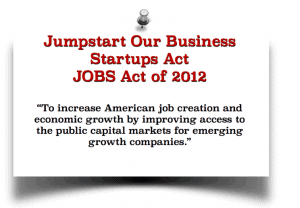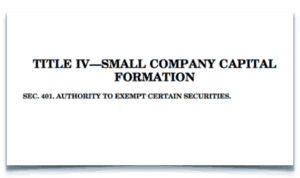If your company has decided to take advantage of the new avenues for reaching investors under Regulation A, the biggest task you face will be preparing an offering statement that includes mandatory disclosures about the offering and the offeror, and obtaining Securities and Exchange Commission (SEC) qualification through the agency’s submission and review process. Like the prospectus in a registered offering, the offering circular is both a selling document that tells the company’s story to potential investors and a compliance document that must impress regulators as a complete and transparent statement of the company’s material information.
 The reward for companies that accept the disclosure requirements of newly revamped Regulation A – commonly referred to as “Regulation A Plus” – is the ability to publicly solicit up to $50 million in debt or equity capital from ordinary investors without going public. A part of the JOBS Act, Regulation A Plus seeks to draw issuers to a middle ground between private offerings that are limited to wealthy “accredited investors” and full-blown registered public offerings.
The reward for companies that accept the disclosure requirements of newly revamped Regulation A – commonly referred to as “Regulation A Plus” – is the ability to publicly solicit up to $50 million in debt or equity capital from ordinary investors without going public. A part of the JOBS Act, Regulation A Plus seeks to draw issuers to a middle ground between private offerings that are limited to wealthy “accredited investors” and full-blown registered public offerings.
This article will provide a general approach to disclosure under Regulation A. Before putting pen to paper – or hiring a lawyer to wield the aforementioned pen – the issuer should understand the goals of securities disclosure and develop a process for turning the Company’s internal information into a public document that closes the books on SEC staff review while opening the pocket books of investors.
To avoid costly and time-consuming missteps in interpreting SEC forms and requirements, the company must obtain advice from a securities attorney with significant experience working with the staff on disclosure issues. Remember, however, outside expertise will never substitute for the Company’s own understanding of disclosure obligations and its officers’ commitment to meeting them.
Background
 The SEC has revamped Form 1-A, which dictates the contents of the offering statement. In particular, it eliminated the previous question-and-answer “Model A” disclosure, calling instead for issuers to provide an “offering circular” that resembles a scaled-down version of the prospectus used in a public offering.
The SEC has revamped Form 1-A, which dictates the contents of the offering statement. In particular, it eliminated the previous question-and-answer “Model A” disclosure, calling instead for issuers to provide an “offering circular” that resembles a scaled-down version of the prospectus used in a public offering.
As used in the regulation, the term “offering statement” refers to the entire submission on Form 1-A, including the exhibits, while “offering circular” refers only to the narrative portion provided in Part II of the offering statement, which will be circulated to potential investors. The terms roughly correspond to the terms “registration statement” and “prospectus” in a registered public offering.
For those eager to see what an offering statement actually looks like, a handful have been publicly filed since the new rules became effective and are accessible on the SEC’s Electronic Data Gathering and Retrieval (“EDGAR”) database (links are provided at the bottom of this article). None of the offerings to date indicates the participation of an underwriter. Most of the issuers are newly formed companies with no history of operations. Until the SEC begins issuing qualification orders on these early submissions, indicating that the staff is satisfied with their contents, it is difficult to recommend using any of them as models. At this point, a company planning a Regulation A offering would be better advised to study prospectuses from completed public offerings in the company’s industry as models, then modify the disclosure to meet the specific requirements of Form 1-A.
Addressing the Three Audiences
Any effective writer first considers the audience with whom he or she will communicate. A Regulation A offering circular, like a prospectus, must address at least three audiences:
- The investor, who may have other information about the company but will be instructed to rely only on the offering circular.
- The staff of the SEC, who will review the offering circular, provide comments, and approve the document only when convinced that it clearly describes all material information about the offeror, with an emphasis on disclosure of risks and uncertainties, and that it fully responds to each item in Form 1-A.
- Future litigators. When drafting an offering document, it is sometimes helpful to imagine the text projected on a courtroom display for jury members to peruse in a lawsuit brought by disappointed investors. When read in hindsight in such a situation, the offering circular should neither contain misleading information nor have misled investors by omitting something important.
 For the first audience, it is essential to succinctly and clearly communicate the company’s business story. But because of the second and third audiences, offering statements typically have a more reserved tone than business plans or other more promotional materials, and investors are accustomed to seeing positive statements about the company’s prospects followed by dire warnings of what could go wrong.
For the first audience, it is essential to succinctly and clearly communicate the company’s business story. But because of the second and third audiences, offering statements typically have a more reserved tone than business plans or other more promotional materials, and investors are accustomed to seeing positive statements about the company’s prospects followed by dire warnings of what could go wrong.
If the issuer engages an underwriter for a Regulation A offering, the underwriter will likely have strong ideas about the form and content of the offering circular, and will certainly participate in the drafting and due diligence process. Often the underwriter will provide the issuer with sample offering documents as models of the underwriter’s preferred style.
Where to Begin – The Business Story
The writer of the offering circular will often begin with the documents the company has used for previous private capital raises, including “angel” or venture capital rounds. A typical offeror will have provided a business plan to investors and strategic partners, which has evolved as the business grew. While it may be out of date or include material that would not be appropriate for an offering statement, like extensive financial projections, the business plan usually contains a useful statement of the company’s basic business model and how it proposes to reward investors.
Critical Contents: MD&A
When evaluating public companies for investment, sophisticated readers often flip to two sections of a company’s prospectus or annual report filed with the SEC: the selected financial information, and the “MD&A” – management’s discussion and analysis of financial condition and results of operations. Form 1-A requires the Regulation A issuer to provide an MD&A, which should give insight into the general development of the company’s business from the point of view of management, including the underlying causes for the historical changes in the key metrics shown in the selected financial table and all material trends and uncertainties identified by management.
The obligation to disclose all material trends and uncertainties identified by management is best illustrated by the SEC’s 1992 enforcement action In the Matter of Caterpillar, Inc. (SEC Release No. 34-30532). In Caterpillar, the company had reported a dramatic increase in sales in its Brazilian unit, but failed to report in MD&A its board of directors’ concern that the increase reflected non-recurring currency changes rather than actual increases in sales volume. The SEC found that the omission violated public company reporting requirements.
Form 1-A will likely be a company’s first encounter with this type of disclosure. It demands the active participation of senior management. Writing and re-writing the MD&A, and vetting it with advisors, will absorb a disproportionate amount of the total time spent on the offering circular.
Financial Data
 Companies with operating history must provide financial statements for the last two completed fiscal years (or since inception, if shorter). Section F/S of the offering circular calls for a balance sheet and statements of income, cash flows and changes in stockholders’ equity. The financial data must be audited in Tier Two offerings – offerings for amounts over $20 million, or for issuers of $20 million or less who opt into Tier Two’s more demanding disclosure regime in order to override state securities qualification requirements. Unlike auditors for registered offerings, the auditor for a Regulation A offering need not be registered with the Public Company Accounting Oversight Board (PCAOB).
Companies with operating history must provide financial statements for the last two completed fiscal years (or since inception, if shorter). Section F/S of the offering circular calls for a balance sheet and statements of income, cash flows and changes in stockholders’ equity. The financial data must be audited in Tier Two offerings – offerings for amounts over $20 million, or for issuers of $20 million or less who opt into Tier Two’s more demanding disclosure regime in order to override state securities qualification requirements. Unlike auditors for registered offerings, the auditor for a Regulation A offering need not be registered with the Public Company Accounting Oversight Board (PCAOB).
Audited financial statements include an auditor’s report and notes to the financial statements that describe nuances in the reported data and variances from the standard classifications under GAAP (generally accepted accounting principles). These notes provide insight into the issuer’s financial condition, and are another section to which sophisticated readers of public company reports often flip first.
Significance for Future Investor Communications
After making a Tier Two Regulation A offering, the issuer must file annual, semi-annual and current reports as specified in the regulation. The disclosure contained in the offering circular will typically provide a template for many sections of the periodic reports to follow. A carefully drafted offering circular can provide for a smooth transition to periodic reports that continue to provide transparency and insight to investors and effectively communicate the company’s business story while satisfying regulatory disclosure requirements. In particular, each Annual Report on Form 1-K will include an updated MD&A, which will build on the narrative established in the offering circular’s MD&A.
The Review Process
Issuers should expect to receive the staff’s initial response to the offering statement within approximately thirty days after submission. The staff will likely provide a number of comments seeking changes in reporting and additional information. Comments often address accounting issues as well. Issuers will want to quickly respond to these comments with an amended Form 1-A and an explanatory comment response letter. Several submissions may sometimes be necessary to resolve all comments and to obtain a qualification order, especially when the issuer has failed to anticipate the SEC staff’s expectations for content and tone in an offering document. In the worst case, the staff may provide a letter with no comments, simply instructing the issuer to read the rules and re-submit; in other words, “start over.”
 Due Diligence
Due Diligence
An entire article could be devoted to discussing the liability of officers and directors for misleading statements in an offering, and the “due diligence” required to limit exposure. The issuer should, at a minimum, assign a responsible officer, typically an accounting professional, to confirm the accuracy of all material statements in the offering circular and to keep a careful record of this review. If the issuer engages an underwriter, the underwriter will have a duty to perform a due diligence review on the offering materials, but the underwriter’s review will not replace the issuer’s duty to confirm that the offering statement contains no false or misleading statements.
Conclusion
 While less burdensome than the process of clearing an IPO registration statement, preparing and qualifying the offering document for Regulation A will still require significant resources and attention. Companies considering a Regulation A offering should account for this in assessing the costs and benefits of Regulation A in comparison to raising capital in a private placement or registered offering. In particular, submitting an ill-prepared offering circular will result in delays and increased costs and could even cause the issuer to miss an opportunity for financing. If you choose to make an offering under Regulation A, you must be prepared to provide frank and balanced disclosures about the company’s prospects, and to invest time, money and management attention in a credible and professional offering circular.
While less burdensome than the process of clearing an IPO registration statement, preparing and qualifying the offering document for Regulation A will still require significant resources and attention. Companies considering a Regulation A offering should account for this in assessing the costs and benefits of Regulation A in comparison to raising capital in a private placement or registered offering. In particular, submitting an ill-prepared offering circular will result in delays and increased costs and could even cause the issuer to miss an opportunity for financing. If you choose to make an offering under Regulation A, you must be prepared to provide frank and balanced disclosures about the company’s prospects, and to invest time, money and management attention in a credible and professional offering circular.
To view samples of recent Form 1-A filings on the SEC’s website – without any recommendation that they be used as models – see the following links. :
 As corporate and securities counsel at Homeier & Law P.C., Charles Kaufman advises companies in commercial and financial transactions, with an emphasis on raising capital through both established techniques and newly emerging ones like crowdfunding. He also counsels public companies on disclosure and compliance matters, especially those who want their reports and offering documents to communicate effectively with investors rather than merely sedating them. He has helped his clients to create, finance, govern, expand across borders, combine and exit their businesses, and to form strategic alliances, across a broad range of industries, including medical devices, healthcare, software, nanotechnology, film and music production, garment manufacturing, retailing, real estate investment and semiconductors. Charles earned both his J.D. and B.A. degrees at the University of California at Los Angeles. He is a member of the State Bar of California and serves on the editorial board of its International Law Journal.
As corporate and securities counsel at Homeier & Law P.C., Charles Kaufman advises companies in commercial and financial transactions, with an emphasis on raising capital through both established techniques and newly emerging ones like crowdfunding. He also counsels public companies on disclosure and compliance matters, especially those who want their reports and offering documents to communicate effectively with investors rather than merely sedating them. He has helped his clients to create, finance, govern, expand across borders, combine and exit their businesses, and to form strategic alliances, across a broad range of industries, including medical devices, healthcare, software, nanotechnology, film and music production, garment manufacturing, retailing, real estate investment and semiconductors. Charles earned both his J.D. and B.A. degrees at the University of California at Los Angeles. He is a member of the State Bar of California and serves on the editorial board of its International Law Journal.
 Jor Law is a co-founder of Homeier & Law, P.C., where he practices corporate and securities law, including helping companies take advantage of alternative forms of capital raising such as Regulation D, Rule 506(c) offerings and crowdfunding. He is also a co-founder of VerifyInvestor.com the resource for accredited investor verifications trusted by broker-dealers, law firms, companies, and investors who insist on safety and reliability.
Jor Law is a co-founder of Homeier & Law, P.C., where he practices corporate and securities law, including helping companies take advantage of alternative forms of capital raising such as Regulation D, Rule 506(c) offerings and crowdfunding. He is also a co-founder of VerifyInvestor.com the resource for accredited investor verifications trusted by broker-dealers, law firms, companies, and investors who insist on safety and reliability.


